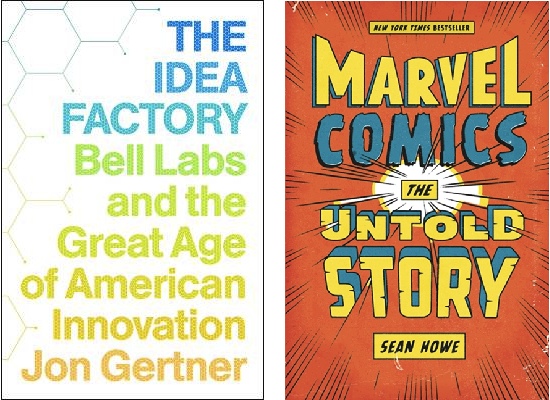Bell Labs and Marvel Comics
December 10, 2012 at 8:52 AM by Dr. Drang
I’ve just finished reading Sean Howe’s Marvel Comics: The Untold Story. This comes just a week or so after reading Jon Gertner’s The Idea Factory: Bell Labs and the Great Age of American Innovation. It’s possible that I would’ve wanted to compare the two even if I’d read them months apart; reading one right after the other made it inevitable.
[Images from Penguin and HarperCollins.]
I picked up Gertner’s book on the tweeted recommendation of Justin Blanton (@jblanton)—our response to James Gleick’s The Information was identical (very good until the last couple of chapters), and Justin thought I’d like Gertner. Howe’s book got a lot of internet hype among the nerd set when it was released earlier this year and was on my list of books to read for months. I liked both books, but if I had to choose one it’d be Gertner, not only because its subject is more substantial, but also because its narrative is better constructed. More on that later.
I was first struck by the odd similarities between Bell Labs and Marvel—the Idea Factory and the House of Ideas. Both were the professional homes of large groups of creative people who built much of today’s American daily life. Marvel’s creations themselves are in the movies we see, and I see a comic book sensibility in the popularity of young adult fiction. The creations of Bell Labs are, of course, working behind the scenes in every device we use above the level of a hammer.
At both places, these people signed away the rights to their creations. Bell Labs gave each new employee a dollar and got, in return, the patent rights to all their inventions. Marvel put boilerplate language on the backs of their checks to artists and writers. When the checks were endorsed to be cashed, Marvel got the rights to the work. In both cases, the arrangement was entered into more or less willingly. To be sure, in the early days Marvel’s artists and writers had little choice—there were no outlets for their talents other than “work for hire.” Later though, when they could own their creations by working with independent comics labels, they still came back to Marvel.
The reason they accepted these asymmetrical arrangements was the same: the arrangement allowed them to do work that couldn’t be done elsewhere. The scientists at Bell Labs could always move into the academic world, and many did, but the interdisciplinary environment at the Labs and the giant machinery of the Bell System behind it gave them the opportunity to see their ideas made real—something universities couldn’t offer. Marvel’s artists and writers found that the independent labels just couldn’t get their books out into the hands of readers the way Marvel (and DC) could.
The biggest difference between the two organizations—apart from the obvious difference in the importance of what they produced—was in their management. Bell Labs was guided by an exceptionally talented group who kept most of their employees engaged in fruitful research while still giving them the freedom that made them both happy and productive. Marvel was run by a succession of B-movie villains who alienated all of their creators.
The books are structured very differently. Gertner focuses on a few individuals and products and each chapter or section follow the path of one of these topics. This makes his book a series of interlocking stories, with each story having its own coherent narrative flow while still fitting in with the book’s overall arc. It’s a design that works well.
Howe, in contrast, tries to be strictly chronological, and the result is often confusing as dozens of characters, most of whom are of little importance to the story, dart in and out of the storyline. Even with the main characters, details are introduced that end up going nowhere. There is, for example, an obsessive chronicling of Stan Lee’s comings and goings, regardless of their effect on Marvel. It’s only in the section on Jim Shooter’s tenure as editor that the chronological approach works narratively, and that’s because the Shooter era has a neatly packaged beginning, middle, and end.
Howe interviewed tons of people in preparing the book, and I get the sense that he wanted to make sure that everyone who talked to him got at least one anecdote. That’s a nice gesture to those people, but wearing on the reader.
I will say, though, that Howe’s summary chapter is excellent—thoughtful, concise, and focused. Gertner, on the other hand, delivers a long and dull exegesis on innovation that has no insights and detracts from an otherwise fine book.
Both books are worth your time. Read Gertner carefully until the he leaves the narrative; skim the rest. Read Howe with as much or as little care as your interest in Marvel minutia allows.

